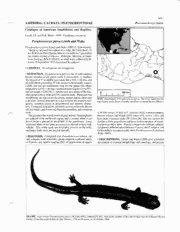
Pseudoeurycea parva PDF
Preview Pseudoeurycea parva
AMPHIBIA: CAUDATA: PLETHODONTIDAE Catalogue of American Amphibians and Reptiles. Lynch, J.F.a nd D.B. Wake. 1999. Pseudoeurycea parva. Pseudoeurycea parva Lynch and Wake Pseudoeurycea parva Lynch and Wake 1989: 15. Type locality, "inside an arboreal bromeliad on a ridge SE Cerro Baul, 21 km W Rizo de Oro,Chiapas, Mexico (ca 1600 m)," just within the eastern border of Oaxaca. Holotype, Museum of Verte- brate Zoology (MVZ) 196101, an adult male, collected by K. Lucas, 8 September 1972 (examined by authors). CONTENT. No subspecies are recognized. DEFINITION. Pseudoeurycea parva is the second-smallest known member of the genus (only f? praecellens is smaller). The largest of 17 available specimens has a SVL = 40 mm, and all individuals exceeding 35 mm appear to be sexually mature. Limbs and tail are moderately long for the genus (for adults projected to a SVL = 40 mm, combined limb length = 0.54 SVL, and tail length = 0.91 SVL). Adults have an average of 80 max- illarylpremaxillary teeth and 50 vomerine teeth. Hand and foot morphology are typical for the genus, except that no tibia1 spur MAP. Distribution of Pseudoeuryceaparva. The circle represents the is present. Sexual dimorphism is not evident, but marked onto- type locality and aclusterof nearby localities in eastern Oaxaca, MCxico. genetic variation occurs in proportional and meristic charac- ters. Compared with adults, juveniles possess relatively shorter tail and limbs, and fewer maxillary/premaxillary and vomerine teeth. = 39 rnm versus 44 mm in P. saltator), have a proportionately The ground color is dark brown or gray-brown. Melanophores shorter relative tail length (0.93 times SVL versus 1.02), and are reduced in the middorsal region, and a creamy white to tan have more vomerine teeth (50 versus 28). The two species are dorsal stripe is present in about half of the specimens. Large similar in limb proportions and have similar numbers of maxil- lichenous white or tan spots are present on the tail in most indi- larylpremaxillary teeth. Protein comparisons indicate substan- viduals. Tiny white spots are invariably present on the belly, tial genetic differentiation between P parva and P. saltator, and and larger light spots are present laterally. between these two species and other Pseudoeurycea (Lynch and Wake 1989). DIAGNOSIS. Compared with Pseudoeurycea saltator, the only congener with which this species might be confused, adults DESCRIPTIONS. Lynch and Wake (1989) give a detailed off? parva are smaller (median SVLof largest third of sample description of external morphology and osteology, and present FIGURE. Adult female Pseudoeurycea parva (38.3 mm SVL), collected by R.L. Seib in the vicinity of the type locality near the Chiapas-Oaxaca border, 23 km (by road) N Rizo de Oro, Mtxico, 1570 m elevation, on 16 October 1984. comparative electrophoretic data for this and seven other spe- ing enlarged nostrils in either juveniles or adults (nostrils are cies of Pseudoeurycea,p lus Dendrotriton,N yctanolis, and Ixalo- invariably enlarged in juvenile Dendrotriton, but not in Pseudo- triton. eurycea): ~seudoeurycea~arsvhaa res some morphological and behavioral similarities with Nvctanolis and Ixalotriton, two ILLUSTRATIONS. Lynch and Wake (1989) presented a monotypic bolitoglossine that occur in eastern chiapas, photograph of a living adult paratype and drawings of a cleared- MCxico and western Guatemala. The small sample available of and-stained hand and foot of a paratype. this species may not include large adults, which would make a relationship to Ixalotriton, which occurs relatively nearby, more DISTRIBUTION. Pseudoeuryceaparva is known only from likely. Electrophoretic data suggest that the closest relative of cloud forest on the flanks of Cerro Baul, a 2,000-m peak lo- l? parva is F! saltator, and that both species are more closely cated just east of the Isthmus de Tehuantepec, near the bound- related to Nyctanolis and Ixalotriton than they are to some spe- ary between the Mexican states of Oaxaca and Chiapas. Speci- cies of Pseudoeurycea (Lynch and Wake 1989). mens have been collected from several localities in easternmost Oaxaca, 17-31 krn W Rizo de Oro, Chiapas. Elevational range LITERATURE CITED is 1,50@1,900 m. Unlike most species of Pseudoeurycea, which are terrestrial, l? parva inhabits arboreal bromeliads (Vriesia Lynch, J.F. and D.B. Wake. 1989. Two new species of Pseudoeurycea and Tillandsia spp.). Bolitoglossa occidentalis is the only sala- (Amphibia:Caudata) from Oaxaca, Mexico. Contrib. Sci. Nat. Hist. mander known to occur in sympatry with l? parva. Mus. Los Angeles Co. (4.11): 11-22. FOSSIL RECORD. None. - - - - - JAMES F. LYNCH, Smithsonian Environmental Research PERTINENT LITERATURE. Morphology, distribution, and Center, Edgewater, MD 21037, USA (deceased), and DAVID relationships are discussed in Lynch and Wake (1989). B. WAKE, Museum of Vertebrate Zoology, University of Cali- fornia, Berkeley, CA 94720-3 160, USA. ETYMOLOGY. The specific name parva is a Latin word meaning "small." Primary editor for this account, Harold A. Dundee. COMMENT. In its habitus and ecology, Pseudoeuryceaparva Published 30 August 1999 and Copyright O 1999 by the Soci- somewhat resembles an oversized Dendrotriton, but differs from ety for the Study of Amphibians and Reptiles. members of that genus in possessing prefrontal bones and lack-
